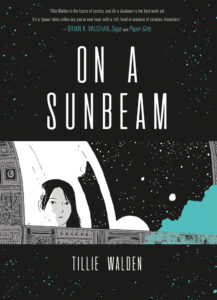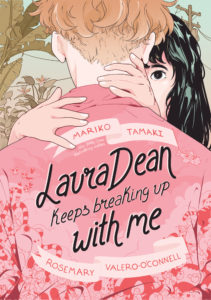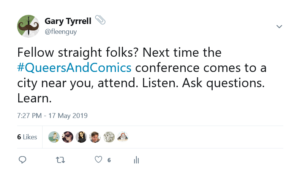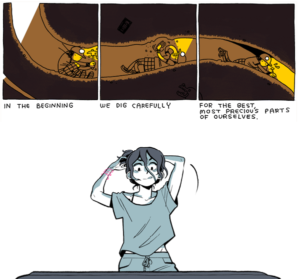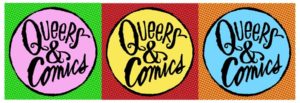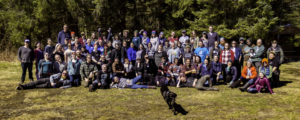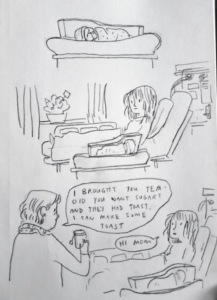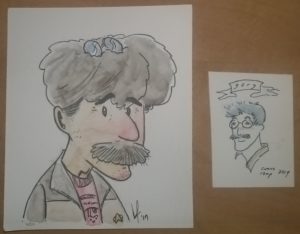Fleen Book Corner: On A Sunbeam
Like a lot of you, I first became aware of Tillie Walden when she started winning Ignatzen a few years back. The webcomic release of On A Sunbeam occurred in short order — nearly a year before Spinning — and I loved both (particularly the big, chapter-long chunks of story released of OAS, making the wait for updates rewarding and full of meaty story progression). But since :01 Books was kind enough to send me a copy of the print release of On A Sunbeam, and since I heard Walden talk about her relationship with her work at the Alaska Robotics Mini-Con¹, I’ve decided to revisit and share my thoughts. It’s going to be light on the spoilers, but I won’t say there are none.
On A Sunbeam is huge. It’s 500 pages (down from 700, Walden said in Juneau; she may not do much in the way of preparatory design or layout in her straight-to-ink process, but she’ll do a hell of a lot of editing later on²) worth of heavy, with a tactile paper and deeply-infused inks that retain hints of their original aroma long after being produced. To read this story in print is an undertaking, a confrontation of physical heft that lends weight to the story. She may regard the book as an afterthought to the act of creation, but when the book is this substantial before you even open it, you feel the work the story required. It demands your attention.
Walden’s not a fan of science fiction and doesn’t claim it as a source of inspiration, so naturally the book is up for a Hugo. Maybe the most radical departure from all but the most recent Hugo winners, the most speculative part of the speculative fiction is that Walden’s imagined a universe not just of life in space and far-flung communities in the firmament, but one where every character but one is female. It’s utterly unremarked-upon, there’s no backstory to say and that’s why there are no more men, it just is, a quiet fact lurking in the background until you realize there’s no dudes.
That one character that’s not female? They’re nonbinary.
Sure, much of the story takes place at a boarding school “For Girls”, or aboard a small ship where there don’t happen to be any men, but then the accumulated weight of the story kicks in. So many references to sisters and daughters, and casual reference to your or my moms. Is it a thesis statement or an aspiration? I think it’s more that there’s nothing in the story — school, bullies, love, family, loss — that requires the presence of men, so there aren’t any. It’s not a society that’s set in opposition to men, or defined by its separation from or absence of men, it just doesn’t have any and possibly never did. It sneaks up on you.
And it’s that casual display of the details of this universe that makes the story and the setting so beautiful. Little grace notes like shoes by the entrance of the spaceship and clutter everywhere tell us this isn’t sweeping space opera, it’s just life that happens to take place in space. Sure, the ships look like carp — complete with eyes and mouths and swimmy fins to keep them aloft — and homes, offices, and school campuses are their own, free-traveling craft, but it’s still just life. Live in a community in a weird part of space that may kill you getting in or out? Cool, you still need horses to get between towns. Want to set up a sports tournament between schools? They’ll need to rendezvous and dock with each other first.
The story is told initially in two threads, today and five years ago, paralleling the experience of the protagonist as she finds love and creates family. Bits of lore drop in conversation and become important, or are utterly forgotten (there’s an offhand reference to Earth, but it seems to be just another place you can live and not the cradle of humanity or anything). The plot in each time progresses on in the way that life does — often mundane, or frustrating, but rarely full of high adventure — until every hundred pages or so, Walden hits us with a showstopper. These moments come out of nowhere, and pack the emotional wallop that an entire series of comics might be built around³. There’s a character break that’s shocking and utterly earned. An act of bravery. A moment of fear and loss.
And in just about the exact middle of the book, the actual thesis statement for On A Sunbeam, and for Walden’s work as a whole:
Have you ever even considered that something that’s trivial to you could mean … so much more to someone else? You don’t get to take the easy road out and just respect the parts of people that you recognize.
That’s goddamn beautiful. More beautiful than the worldbuilding and imagination and the gorgeous illustrations. The most important thing is being willing to extend respect to somebody who’s different, whether you’re in a universe of fish-ships and schools wafting among the stars or not. You don’t get to decide what’s important for anybody other than yourself.
Take your time with On A Sunbeam; read it, exist in the story, listen to what it has to say. Set it aside for a day, or a month, and come back to it again; new little details will jump out at you, obvious now in ways they weren’t before. Read it again in a year, two, ten, and let it lead you back into that place where respect can be required, and love and family can be the foundation you build upon.
Spam of the day:
But if you’re still stuck on squats and lunges to grow your butt, you need to stop NOW.
Maybe you need to stop now, but my butt is friggin’ glorious.
_______________
¹ And, at various points, we discussed other things, including what winning fuck-you lottery money would mean, desert island books, and Game Of Thrones. She’s really smart and utterly sincere and has become one of my favorite people.
² Which, if you recall our prior discussions of how Mark Siegel prefers to approach editing in :01 releases, is a unique way of working. Add to the fact that the story was done in about a year, including living overseas, and it’s pretty much inconceivable that the book actually exists. Only the most monstrous of work ethics could actually result in this story seeing completion.
³ Think Superman and Regan on the ledge, or Old Doreen and Old Nancy deciding to go back in time knowing it’ll reset their decades-long love, but they’ll find a way to recreate it.
